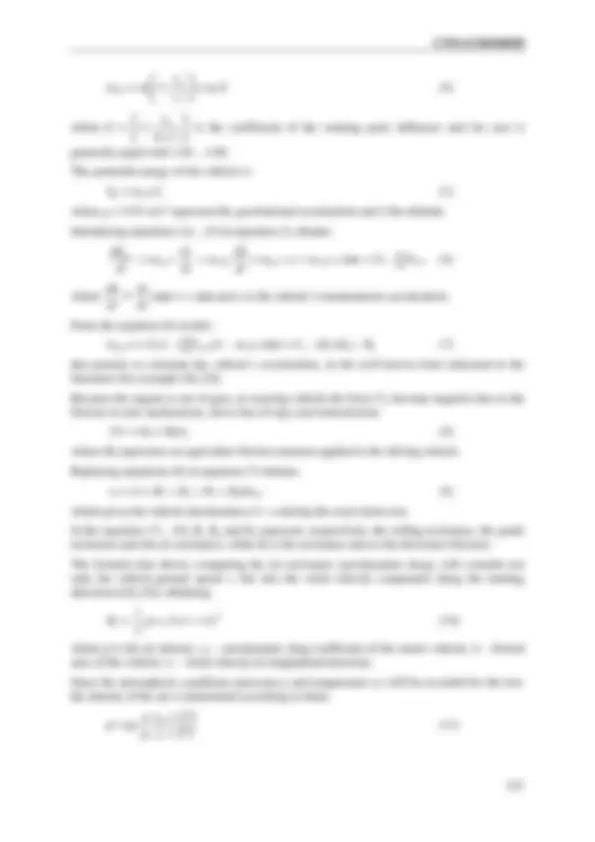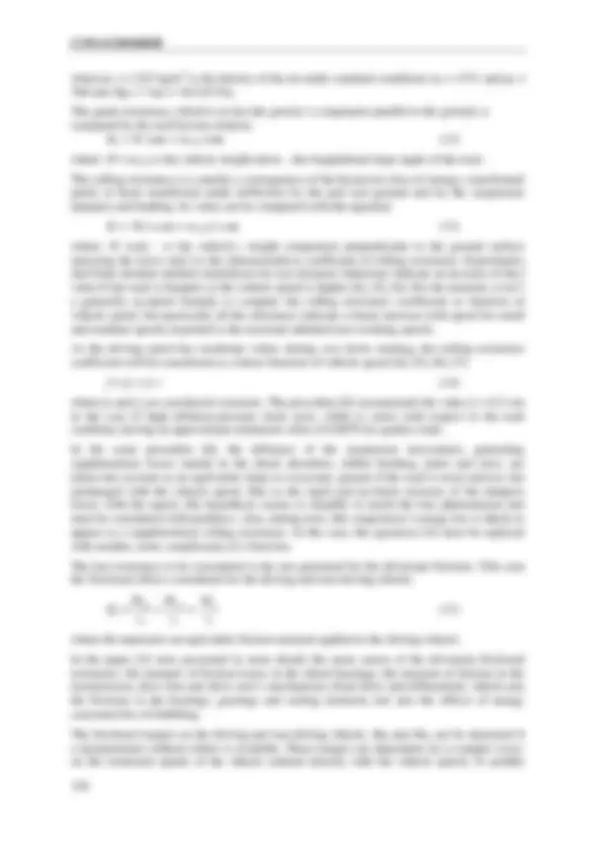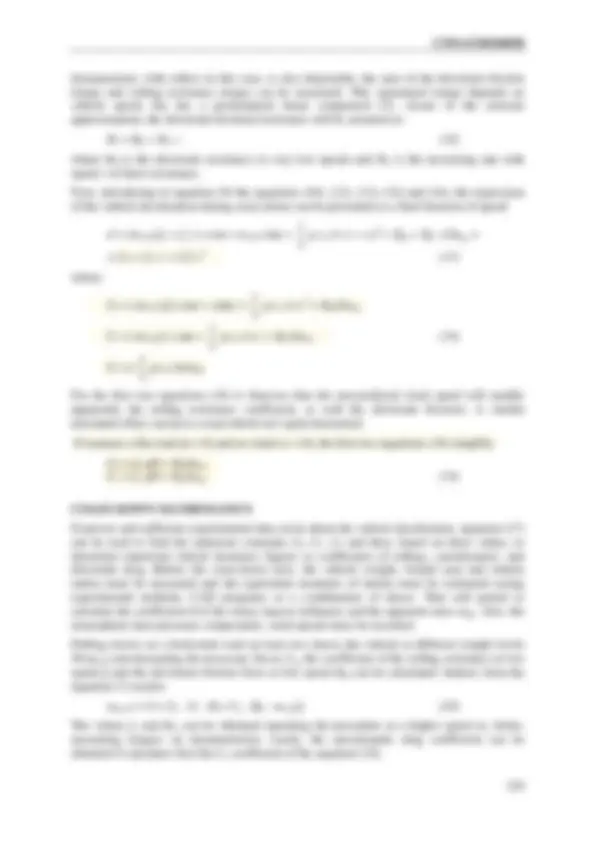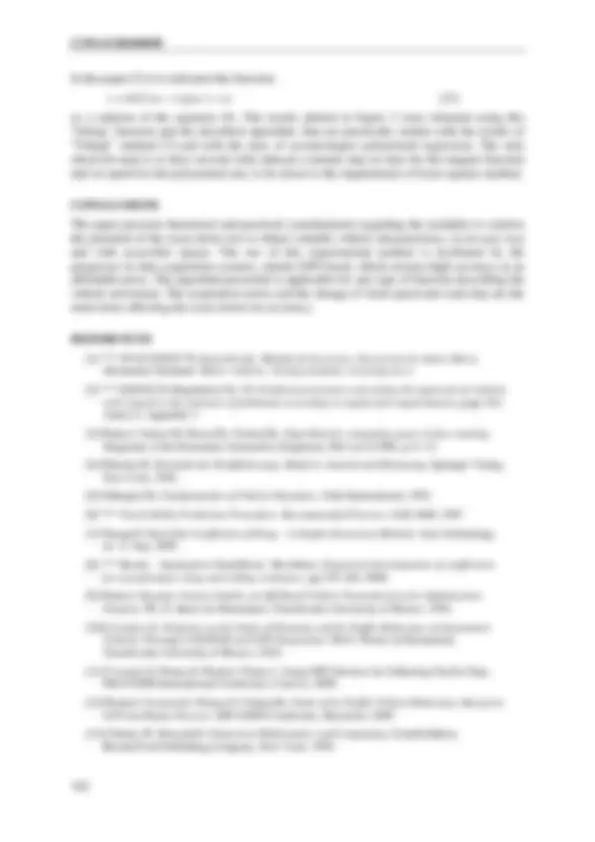






Study with the several resources on Docsity

Earn points by helping other students or get them with a premium plan


Prepare for your exams
Study with the several resources on Docsity

Earn points to download
Earn points by helping other students or get them with a premium plan
Community
Ask the community for help and clear up your study doubts
Discover the best universities in your country according to Docsity users
Free resources
Download our free guides on studying techniques, anxiety management strategies, and thesis advice from Docsity tutors
A study on the coast-down test, a common method for evaluating the resistances acting on motor vehicles. The paper discusses the utility, suitability, and limits of this test, providing mathematical methods to estimate vehicle movement resistances based on regression. The study includes data obtained using the coast-down method with different test vehicles and in various road conditions.
Typology: Papers
1 / 8

This page cannot be seen from the preview
Don't miss anything!





- THEORETICAL AND EXPERIMENTAL APPROACH
Ion Preda, Dinu Covaciu, Gheorghe Ciolan
Transilvania University of Brasov, Romania
KEYWORDS – coast down test, vehicle resistances prediction, rolling resistance, aerodynamic drag, data smoothing ABSTRACT – The paper presents considerations about the utility, suitability and limits of the coast-down experimental test in the automotive research. That test consists in launching of a motor vehicle from a certain speed with the engine disengaged and ascertaining of the current speed and distance covered during the free rolling, till vehicle stops. First it is indicated a modality to determine by computation the vehicle kinematics. There are presented the vehicle resistances, the assumptions and the values influencing the analyzed process. Then, there are established the mathematical equations necessary to ascertain the speed and distance during cost-down. By the analysis of the different factors influences it can be determined the necessary precision of measurements, so that the results of the test might be conclusive. Reciprocally, when experimental data exists, mathematical methods based on regression are presented to estimate the vehicle movement resistances. In the paper are presented data obtained using coast-down method with different test vehicles and in various road conditions. The results include estimated values for the rolling resistance coefficient and aerodynamic drag coefficient. New ideas for additional valorisation of the method are also indicated.
Coast down is one of the most frequent tests for motor vehicles and consists in vehicle launch from a certain speed with the engine ungeared, simultaneously recording the speed and travelled distance until vehicle stops. This can be done for different reasons, mainly targeting to obtain valuable information about the general condition of the vehicle and about its interaction with the environment.
One main aim of this test is to evaluate the values of the resistant forces acting on the vehicle at certain speed and road conditions, so that to have the possibility to reproduce them on proving stands (dynamometers with or without rollers) for the measuring of fuel consumption, chemical or noise pollution or for other purposes. Another aim is to determine some possible abnormalities in the functioning of some subassemblies of the motor vehicle, i.e. to establish if the vehicle technical condition is acceptable in order to subject it to other, more complex, tests. The requirements to perform this kind of coast down tests are standardized [1], [2]. The value of coasting (free running) distance is then compared to values corresponding to some similar or closely related types of vehicles.
But these figures are not always available, especially when testing new models, which led to the idea of determining by computation the value of coasting distance and the vehicle’s general dynamics. What follows is a briefing of the procedure proposed by the authors and that was used to realize a computer program. The results of simulation were confronted with experimental results, the model and the adopted hypothesis being satisfactory. The algorithm
is likely to be improved as well as more new ideas and experimental data will be accumulated.
To obtain the movement equation of the vehicle, some simplifying hypotheses and a simple dynamic model were adopted [3]. The dynamic model was imagined based on the assumption that the motor vehicle consists of:
For the coast down test will be assumed a road not too bumpy. Also, because the engine is disconnected, the wheels are not loaded with heavy moments. In these conditions, it can be assumed constant dynamic radius r d for the vehicle wheels and very small tyre-ground slip. That means no energy loss will be generated by slip.
During moving, the vehicle interacts with the environment. As a result, some forces acts against it (figure 1): the vehicle gravitational force (the weight) W , inducing the reaction forces Z 1 and Z 2 normal to the road surface which, in turn, determines the rolling resistance forces F r1 and F r2 on the wheels of the front and rear axles, respectively; the air resistance force (aerodynamic drag) F a; the driving force at the wheel F w that propel the vehicle.
Fig. 1 – The external forces acting on a rolling vehicle
To obtain the equation of the vehicle motion, will be applied the principle of energy conservation, that states the derivative (the instantaneous change rate) of the vehicle’s total mechanical energy is equal with driving power P w minus the total power losses:
dt
dEtot = Pw - ∑Ploss (1)
The vehicle’s mechanical energy consists on the kinetic energy E k of the parts in translation and rotation and on potential energy E p, determined by the vehicle altitude:
Etot = Ek + Ep = Ekt +Ekr + Ep (2)
The kinetic energy E k include the one of the translational mass and those of any rotating part j kinematically connected with the wheels:
j
mt v Ij j 2 2
(^2) ω 2 = 2 2
2 2
m v^2 ap (^) (3)
where ω w = v r d is the rotation speed of the wheels driving. The vehicle behaves as having a bigger mass, the apparent mass m ap:
where ρ 0 = 1.225 kg/m^3 is the density of the air under standard conditions (t 0 = 15°C and p 0 = 760 mm Hg = 1 bar = 101325 Pa).
The grade resistance, which is in fact the gravity’s component parallel to the ground, is computed by the well known relation: Rg = W sinα = mt g sinα (12)
where: W = m t g is the vehicle weight and α – the longitudinal slope angle of the road.
The rolling resistance is a mainly a consequence of the hysteresis (loss of energy, transformed partly in heat) manifested under deflection by the pair tyre-ground and by the suspension dampers and bushing. Its value can be computed with the equation:
Rr = W f cosα = mt g f cosα (13)
where: W cosα – is the vehicle’s weight component perpendicular to the ground surface (pressing the tyres) and f is the (dimensionless) coefficient of rolling resistance. Experiments and finite element method simulations for tyre dynamic behaviour indicate an increase of the f value if the road is bumpier or the vehicle speed is higher [4], [5], [6]. For the moment, it isn’t a generally accepted formula to compute the rolling resistance coefficient as function of vehicle speed, but practically all the references indicate a linear increase with speed for small and medium speeds (reported to the maximal admitted tyre working speed).
As the driving speed has moderate values during cost down running, the rolling resistance coefficient will be considered as a linear function of vehicle speed [4], [5], [6], [7]:
f = f 0 + f 1 v (14)
where f 0 and f 1 are considered constants. The procedure [6] recommends the value f 1 = 0.2 s/m in the case of high inflation-pressure truck tyres, while f 0 varies with respect to the road condition, having an approximate minimum value of 0.0076 for quality roads.
In the same procedure [6], the influence of the suspension movements, generating supplementary losses mainly in the shock absorbers, rubber bushing, joints and tyres, are taken into account as an equivalent slope to overcome, greater if the road is more uneven, but unchanged with the vehicle speed. Due to the rapid and un-linear increase of the dampers forces with the speed, this hypothesis seems to simplify to much the true phenomenon and must be considered with prudence. Also, during tests, this suspension’s energy loss is likely to appear as a supplementary rolling resistance. In this case, the equation (14) must be replaced with another, more complicated, f(v) function.
The last resistance to be considered is the one generated by the drivetrain frictions. This sum the frictional effects considered for the driving and non-driving wheels:
Rf = n
fn d
fd r
r
w
f r
where M f represents an equivalent friction moment applied to the driving wheels.
In the paper [3] were presented in more details the main causes of the drivetrain frictional resistance: the moment of friction losses in the wheel bearings; the moment of friction in the transmission, drive line and drive axle’s mechanisms (final drive and differential), which sum the frictions in the bearings, gearings and sealing elements, but also the effects of energy consumed for oil bubbling.
The frictional torques on the driving and non-driving wheels, M fd and M fn can be measured if a dynamometer without rollers is available. These torques are dependent (in a complex way), on the rotational speeds of the wheels (related directly with the vehicle speed). If another
dynamometer, with rollers in this case, is also disposable, the sum of the drivetrain friction torque and rolling resistance torque can be measured. This summated torque depends on vehicle speed, but has a predominant linear component [7]. Aware of the extreme approximation, the drivetrain frictional resistance will be assumed as:
Rf = Rf0 + Rf1 v (16)
where R f0 is the drivetrain resistance at very low speeds and R f1 is the increasing rate with speed v of these resistance.
Now, introducing in equation (9) the equations (10), (12), (13), (14) and (16), the expression of the vehicle deceleration during coast-down can be presented as a final function of speed:
d = [mt g (f 0 + f 1 v) cosα + mt g sinα + 2
ρ cd A (v + w)^2 + Rf0 + Rf1 v]/map =
= C 0 + C 1 v + C2 v^2 (17)
where:
C 0 = [mt g (f 0 cosα + sinα) + 2
ρ cd A w^2 + Rf0]/map
C 1 = (mt g f 1 cosα + 2
ρ cd A w + Rf1)/map (18)
ρ cd A)/map
For the first two equations (18) it observes that the unconsidered wind speed will modify apparently the rolling resistance coefficient, as well the drivetrain frictions. A similar unwanted effect can have a road which isn’t quite horizontal.
If assumes a flat road ( α = 0) and no wind ( w = 0), the first two equations (18) simplify: C 0 = f 0 g/δ + Rf0/map C 1 = f 1 g/δ + Rf1/map (19)
If precise and sufficient experimental data exists about the vehicle deceleration, equation (17) can be used to find the unknown constants C 0 , C 1 , C 2 and then, based on these values, to determine important vehicle dynamics figures as coefficients of rolling-, aerodynamic- and drivetrain drag. Before the coast-down tests, the vehicle weight, frontal area and wheels radius must be measured and the equivalent moments of inertia must be estimated (using experimental methods, CAD programs or a combination of these). That will permit to calculate the coefficient δ of the rotary masses influence and the apparent mass m ap. Also, the atmospheric data (pressure, temperature, wind speed) must be recorded.
Pulling slowly on a horizontal road (at least two times) the vehicle at different weight levels W = m t g and measuring the necessary forces F p, the coefficient of the rolling resistance at low speed f 0 and the drivetrain friction force at low speed R f0 can be calculated. Indeed, from the equation (7) results:
map a = 0 = Fp - Ff - Rr= Fp - Rf0 - mt g f 0 (20)
The values f 1 and R f1 can be obtained repeating the procedure at a higher speed or, better, measuring torques on dynamometers. Lastly, the aerodynamic drag coefficient can be obtained if calculates first the C 2 coefficient of the equation (18).
The sample rate of these systems varies from 1 Hz to 100 Hz. The data available are the time, the speed and the distance (excepting the vehicle’s computer). The Correvit system offers also the acceleration. The filtering methods, excepting the “in house” systems, are less- or un- known. Practically, all systems used in these work measure the time and the distance. Then, by numerical derivation, it calculates the speed. Some GPS-based systems (as Racelogic Vbox) use also the Doppler effect to diminish the speed errors. Excepting the Correvit system, that repeats the derivation of the speed to obtain the acceleration, the use of all other presented systems needs numerical methods to calculate the acceleration.
Fig. 2 – Least-squares approximation of experimental data (107 V-D points) with a second degree polynomial: d(v)= 0.135+0.00104 v + 0.00025 v^2 (v in m/s, cd=0.342)
Fig. 3 – Least-squares approximation of experimental data (91 T-V points) with a tangent function having the derivative: d(v)= 0.133+0.00140 v + 0.00024 v^2 (v in m/s, cd=0.342)
In this work were tried (with almost similar results) two formulas for numerical derivative, needing respectively three and five neighbouring points ( T i, V i) [13]:
Di = 1 1
1 1
−
− −
i i
i i T T
Di = 6 ( )
1 1
2 1 1 2
− − + + −
i i
i i i i T T
Figure 2 shows how a second degree polynomial approximate, in the least-squares sense, the “cloud” of experimental points ( V i, D i).
In the paper [7] it is indicated the function:
v =-b/(2 a) – r tg(u t + w) (25)
as a solution of the equation (9). The results plotted in figure 3 were obtained using this “fitting” function and the described algorithm, that are practically similar with the results of “Takagi” method [7] and with the ones of second-degree polynomial regression. The only observed need is to have records with (almost) constant step on time for the tangent function and on speed for the polynomial one, to be closer to the requirements of least-squares method.
The paper presents theoretical and practical considerations regarding the modality to valorise the potential of the coast-down test to obtain valuable vehicle characteristics, in an easy way and with accessible means. The use of this experimental method is facilitated by the progresses in data acquisition systems, mainly GPS based, which ensures high accuracy at an affordable price. The algorithm presented is applicable for any type of function describing the vehicle movement. The acquisition errors and the change of wind speed and road slop are the main items affecting the coast-down test accuracy.
[1] *** STAS 6926/9-70 Autovehicule. Metode de încercare. Incercarea la rulare libera. (Romanian Standard: Motor vehicles. Testing methods. Coasting test. ) [2] *** E/ECE/324 Regulation No. 83 ( Uniform provisions concerning the approval of vehicles with regard to the emission of pollutants according to engine fuel requirements ), page 101, Annex 4, Appendix 3 [3] Preda,I. Untaru.M. Peres,Gh. Ciolan,Gh. Algorithm for computing space in free running. Magazine of the Romanian Automotive Engineers, RIA no.2/1990, p.11-13. [4] Mitscke,M. Dynamik der Kraftfahrzeuge. Band A: Antrieb und Bremsung , Springer Verlag, New York, 1982. [5] Gillespie,Th. Fundamentals of Vehicle Dynamics. SAE International, 1992. [6] *** Truck Ability Prediction Procedure. Recommended Practice. SAE J688, 1987. [7] Takagi,H. Real-Life Coefficient of Drag – A Simple Extraction Method. Auto Technology no. 4, Aug. 2005. [8] *** Bosch – Automotive Hand Book. 5th edition. Empirical determination of coefficients for aerodynamics drag and rolling resistance. pp.339-340, 2000. [9] Preda,I. Dynamic Strains Studies on Off-Road Vehicle Transmissions for Optimization Purpose. Ph. D. thesis (in Romanian), Transilvania University of Brasov, 1994. [10] Covaciu, D. Solutions on the Study of Dynamic and In-Traffic Behaviour of Automotive Vehicles Through CAD/PLM and GPS Integration. Ph.D. Thesis (in Romanian), Transilvania University of Brasov, 2010. [11] Covaciu,D. Florea,D. Preda,I. Timar,J. Using GPS Devices for Collecting Traffic Data. SMAT2008 International Conference, Craiova, 2008. [12] Preda,I. Covaciu,D. Florea,D. Ciolan,Gh. Study of In-Traffic Vehicle Behaviour, Based on GPS and Radar Devices. ESFA2009 Conference, Bucuresti, 2009. [13] Cheney,W. Kincaid,D. Numerical Mathematics and Computing. Fourth Edition. Brooks/Cole Publishing Company, New York, 1999.